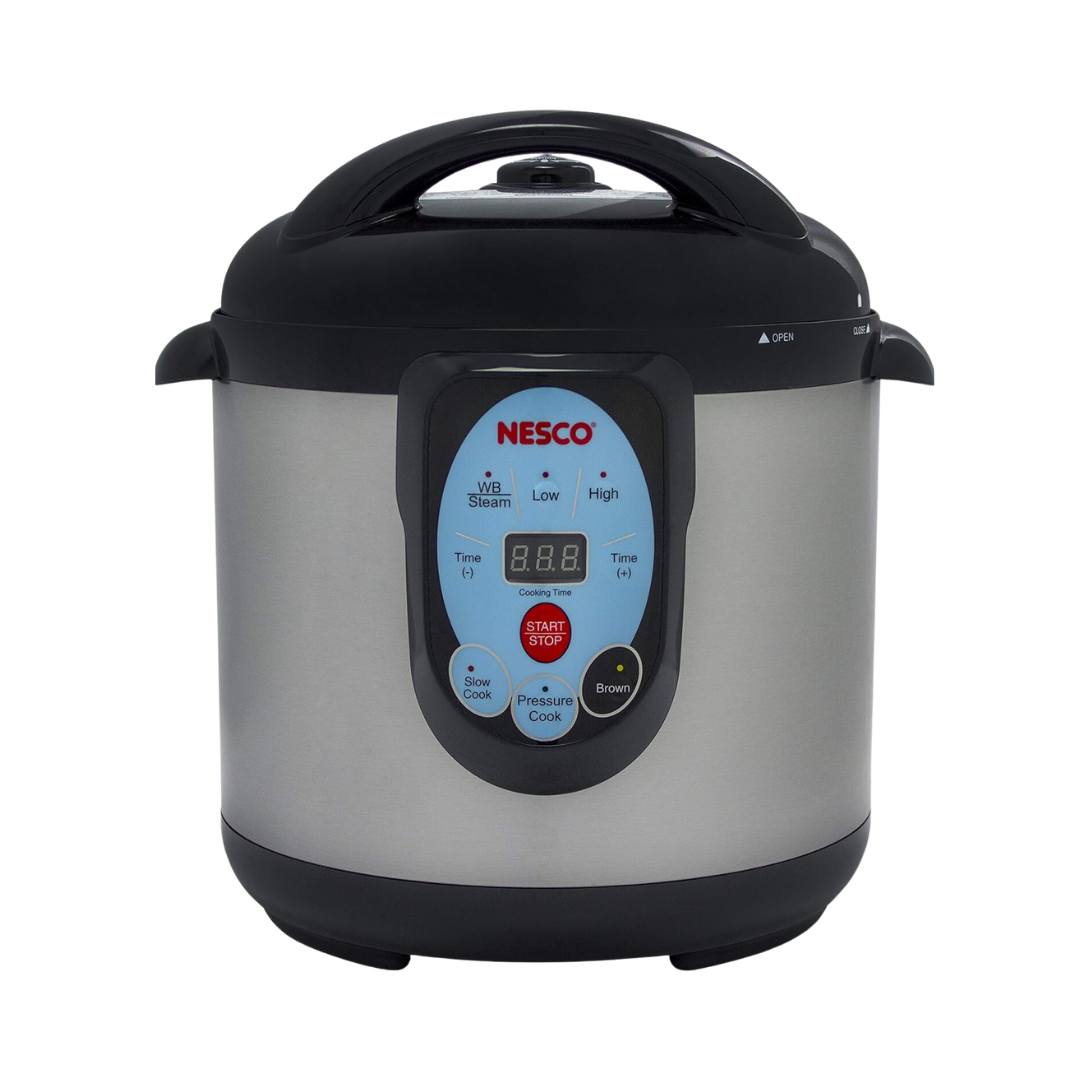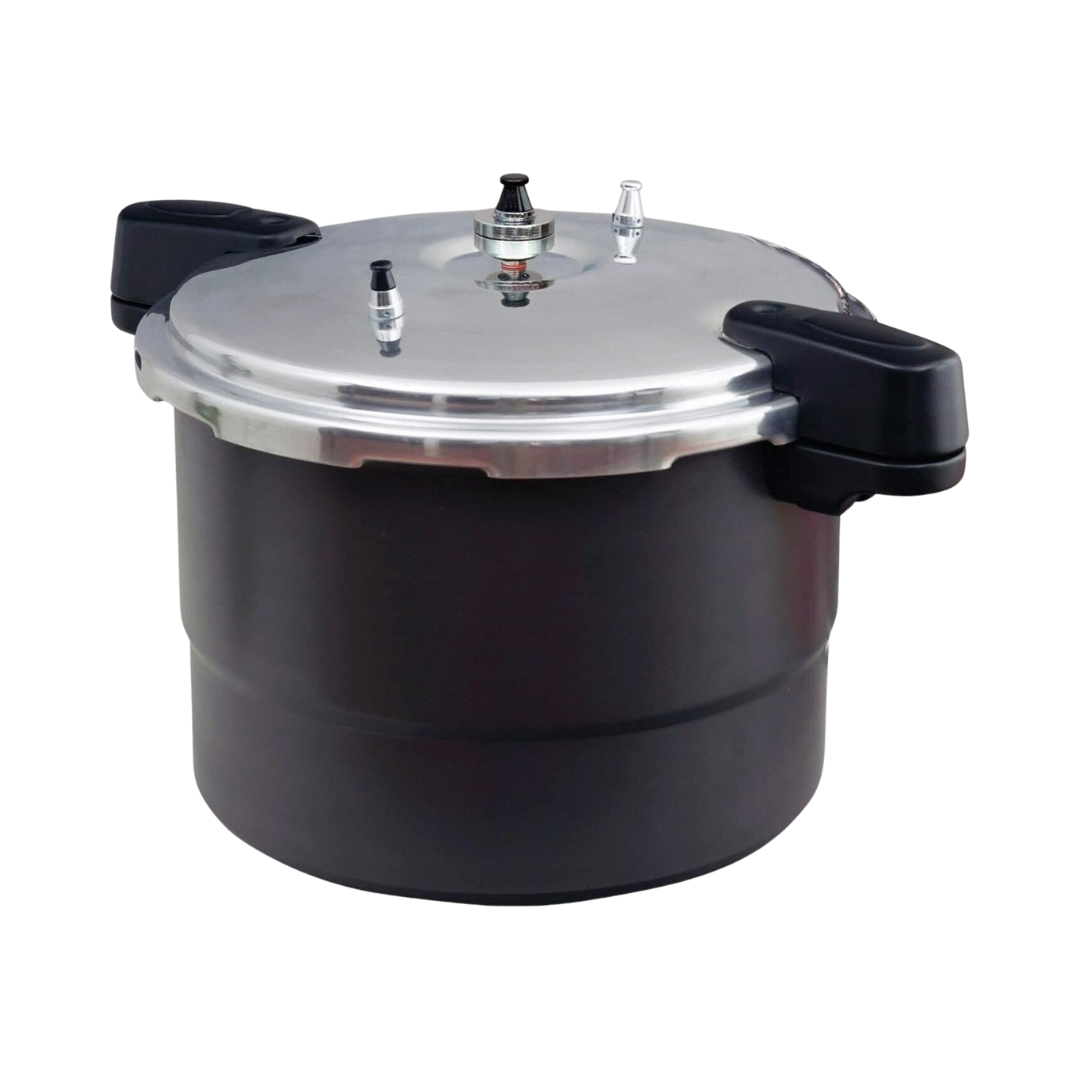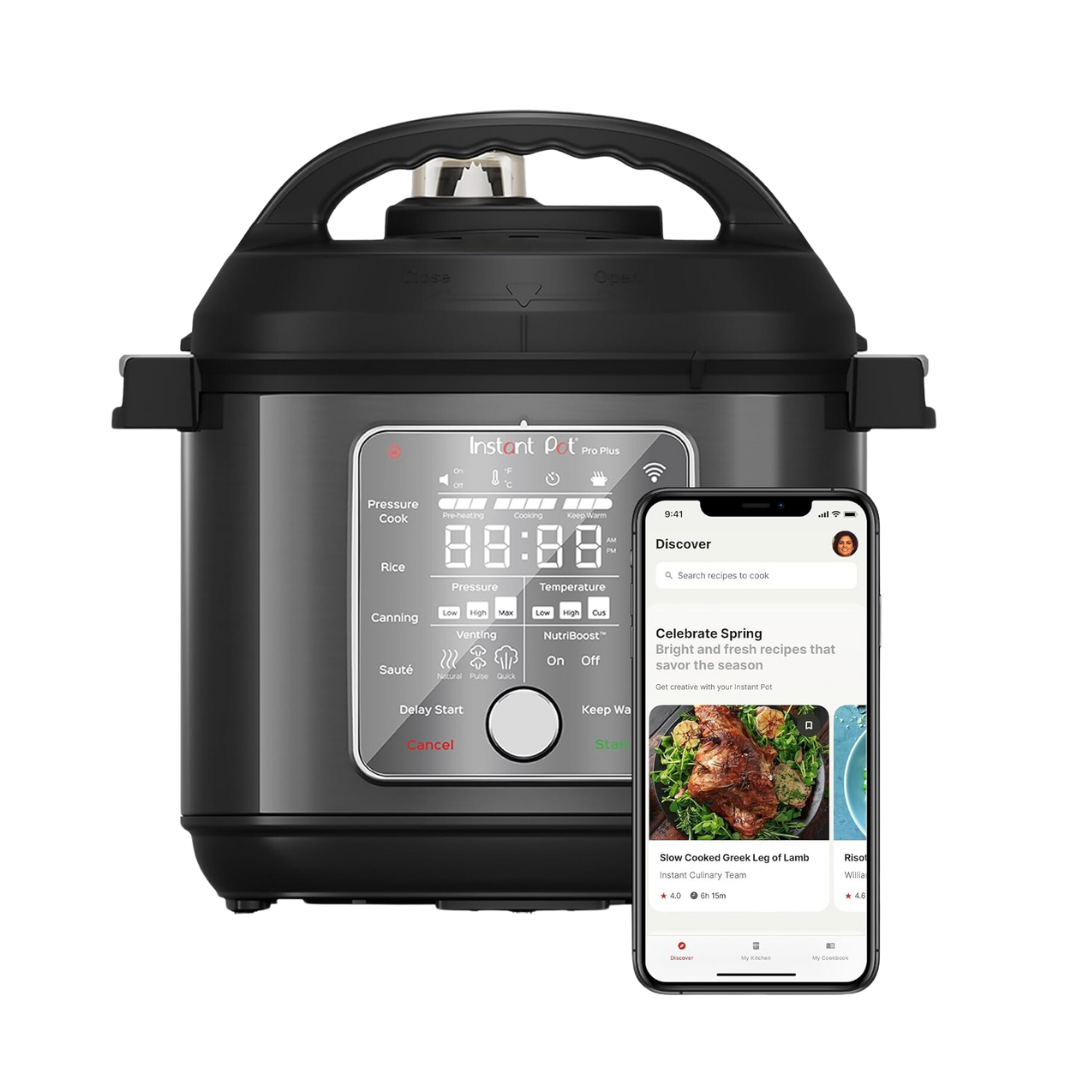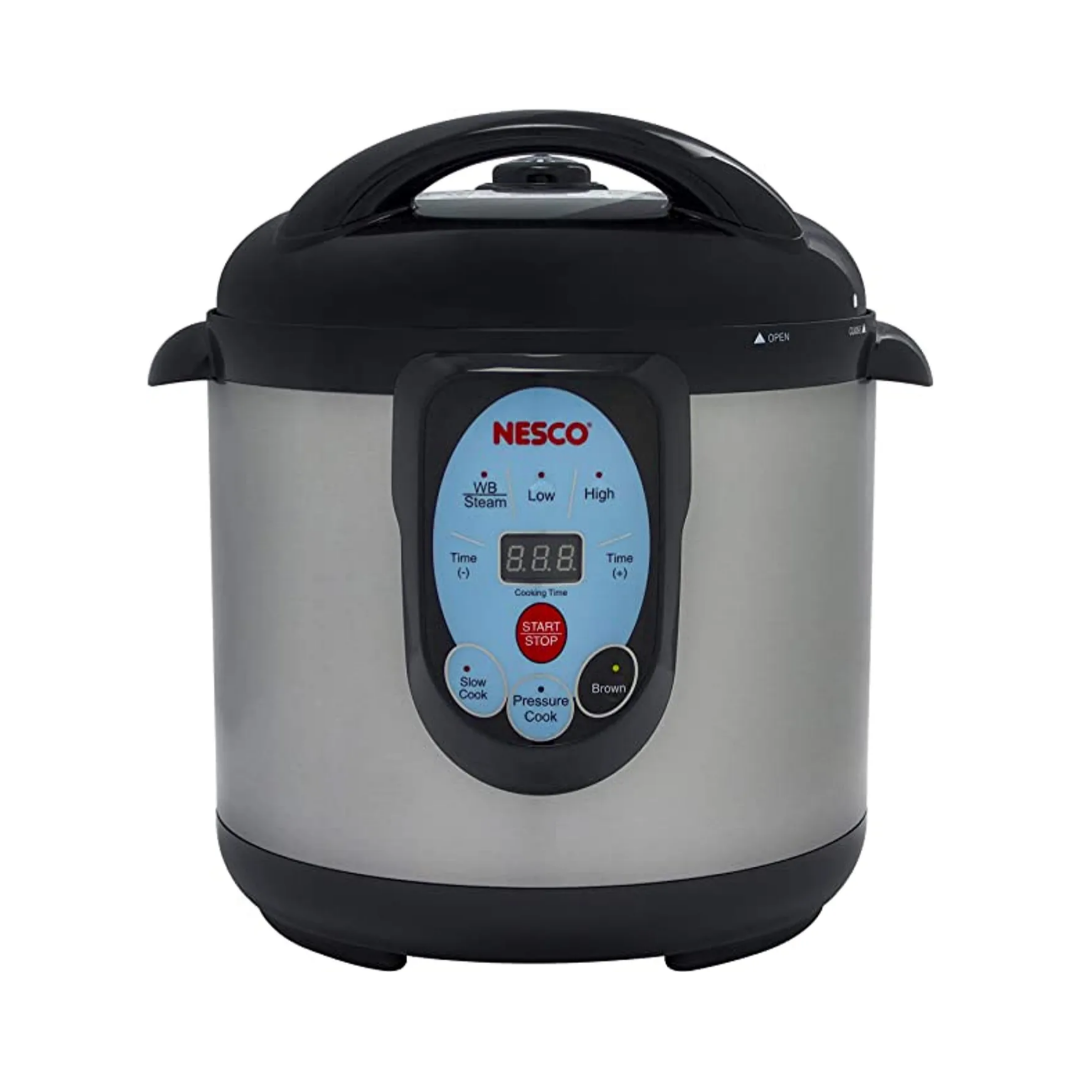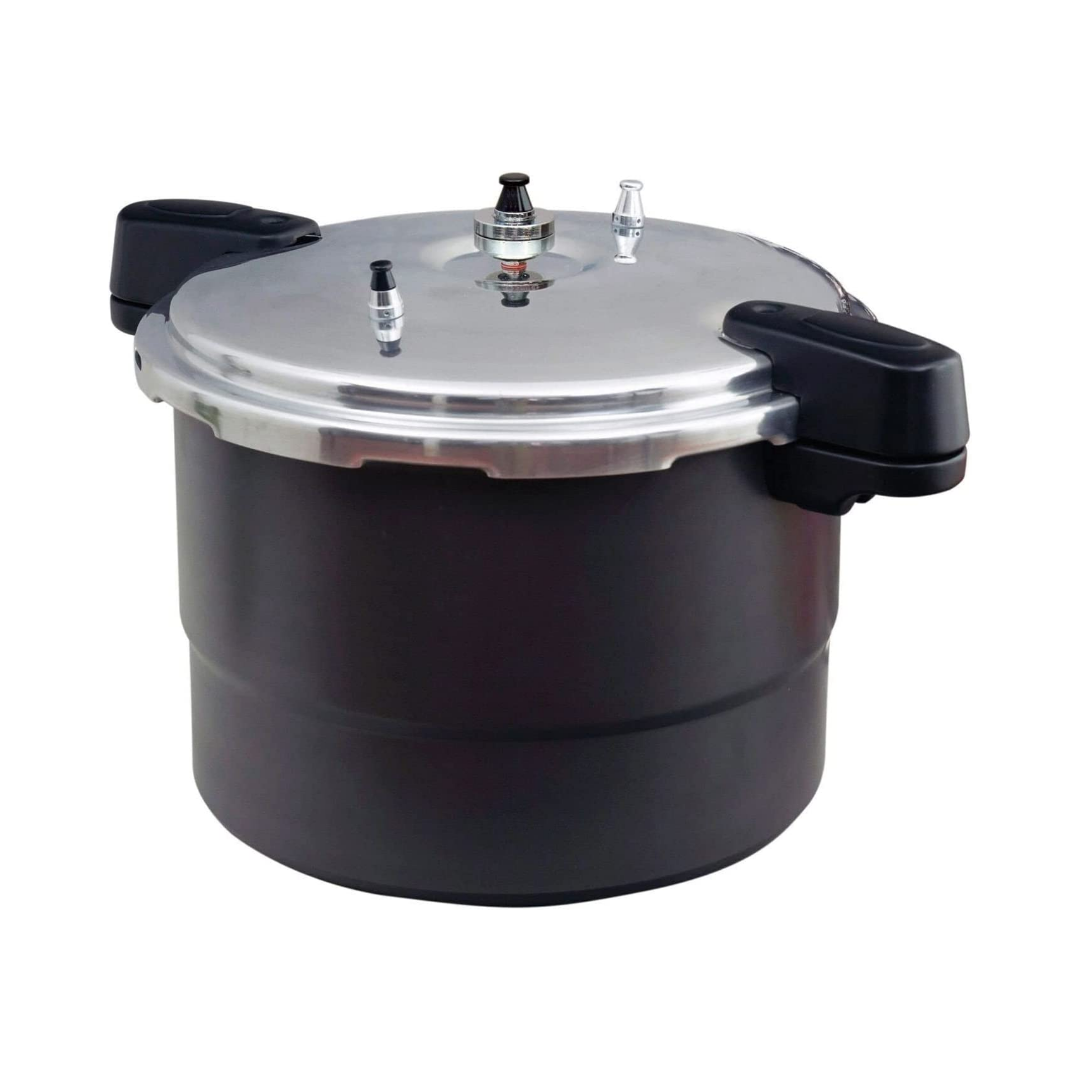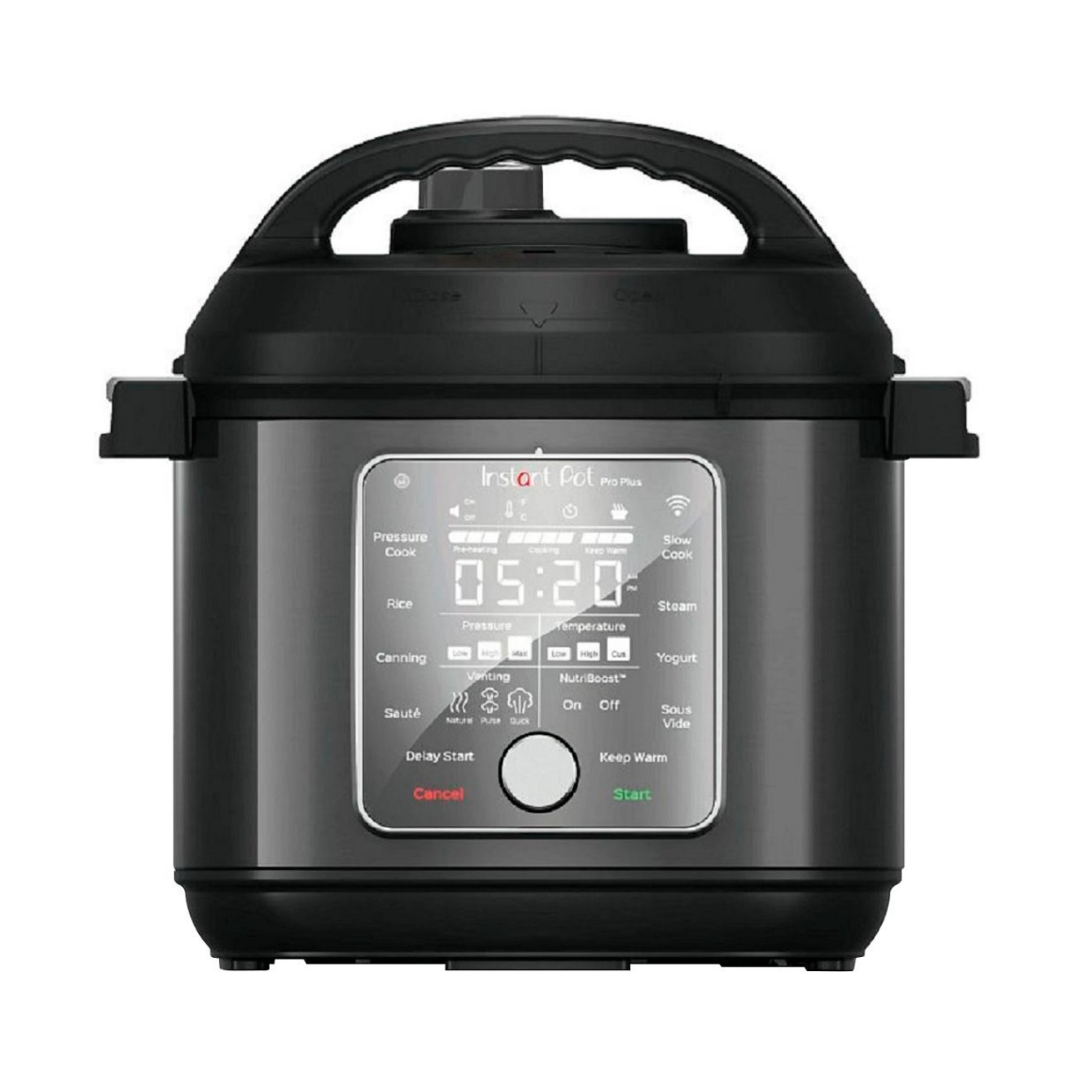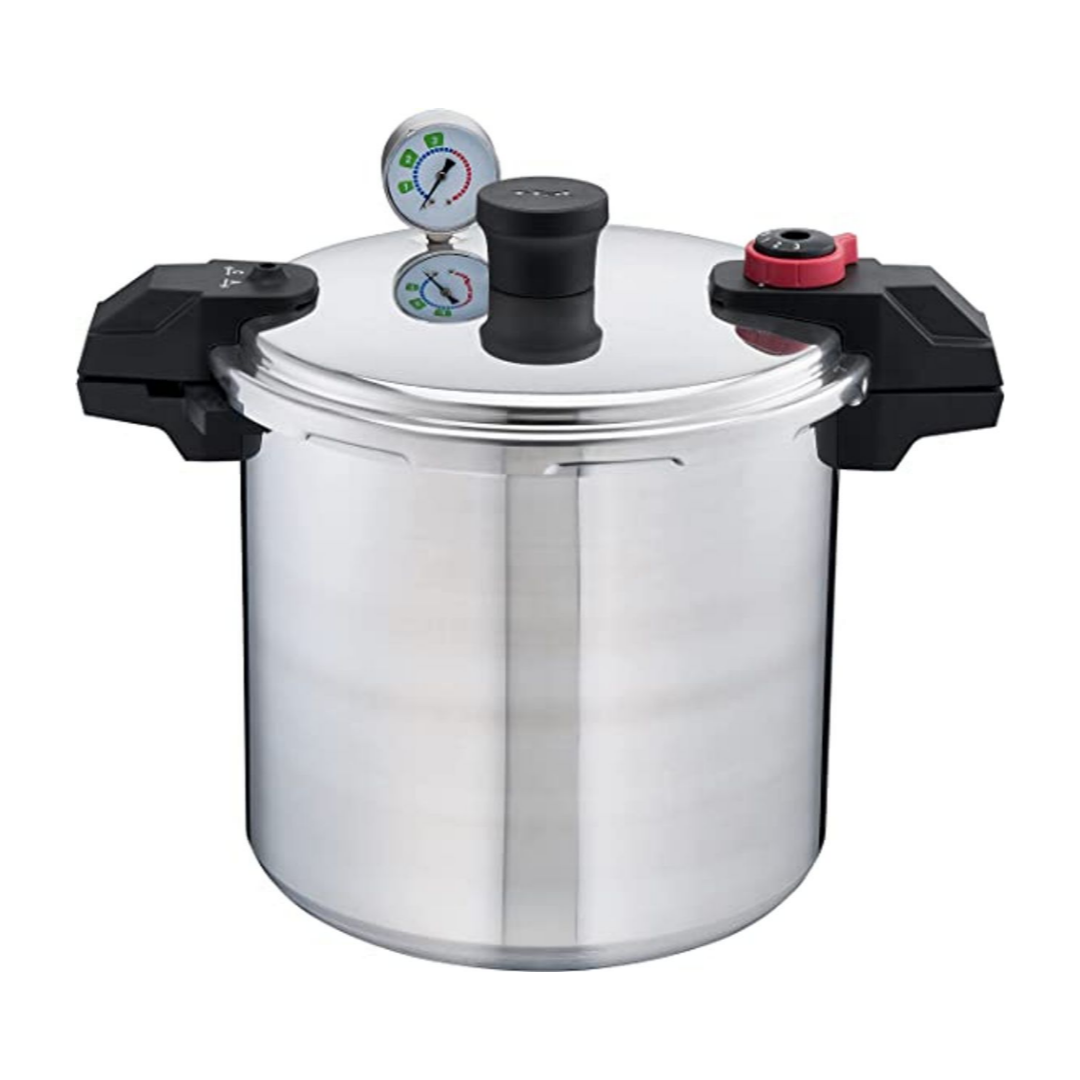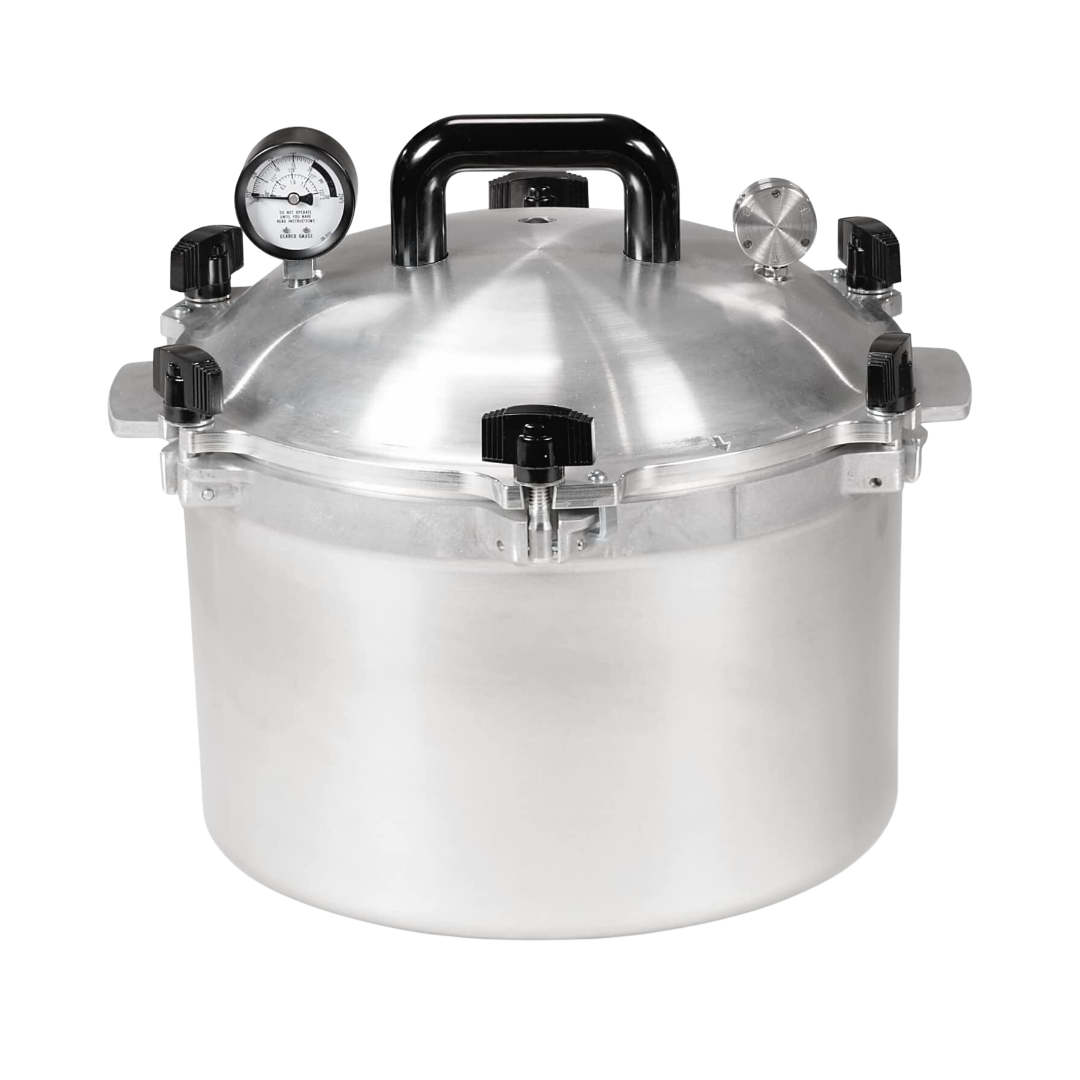We may be compensated if you purchase through links on our website. Our team is committed to delivering honest, objective, and independent reviews on home products and services.
A pressure canner is the safest and most effective way to preserve low-acid foods, such as corn, fish, meat, and green beans, without pickling or using a vacuum sealer. While they used to be a hazardous means of preserving food, modern pressure canners are engineered with strong materials, airtight seals, and built-in pressure regulators to make the process as safe as possible.
If you’re new to the world of pressure canning or simply seeking the right model for your kitchen, our team is here to help. We researched the best pressure canners on the market and rounded up our top five recommendations to suit different homeowners’ canning needs.
Top 5 Pressure Canners
- Best Pressure Canner Overall: NESCO Smart Electric Pressure Cooker and Canner
- Best 3-In-1 Pressure Canner: Granite Ware Pressure Canner and Cooker
- Most Versatile Pressure Canner: Instant Pot 10-in-1 Pressure Cooker and Canner
- Best Large Pressure Canner: T-fal Pressure Cooker and Canner
- Best Pressure Canner Lid: All American Pressure Cooker and Canner
Compare Top Pressure Canners
| Product | Capacity | Material | Multifunction | Weight | Dimensions |
|---|---|---|---|---|---|
| NESCO Smart Electric Pressure Cooker and Canner | 9.5 qt | Stainless steel | Yes | 22 pounds | 14 x 15 x 14.5 inches |
| Granite Ware Pressure Canner and Cooker | 20 qt | Anodized aluminum | No | 11 pounds | 14.5 x 14.3 x 13.4 inches |
| Instant Pot 10-in-1 Pressure Cooker and Canner | 6 qt | Aluminum and stainless steel | Yes | 21 pounds | 15.2 x 15.2 x 15.2 inches |
| T-fal Pressure Cooker and Canner | 22 qt | Aluminum and stainless steel | No | 15 pounds | 19.3 x 15.4 x 16.3 inches |
| All American Pressure Cooker and Canner | 15.5 qt | Aluminum | No | 15 pounds | 18 x 16 x 10 inches |
| Product | Capacity | Material | Multifunction | Weight | Dimensions |
Best Pressure Canner Overall: NESCO Smart Electric Pressure Cooker and Canner
Pros and Cons
✔ Contains a nonstick aluminum cooking chamber that is dishwasher safe
✔ Includes standard and high-altitude limiting valves at 10 and 15 PSI, respectively
✔ Has an integrated lid-locking protection system for safety
✘ Can only fit four quart-size jars at a time
✘ Received customer feedback citing inconsistent pressure canning results
Good for: This simple electric pressure canner is good for those new to pressure canning who want an easy-to-use, low-capacity option.
What Customers Are Saying
This electric pressure cooker and canner received primarily positive reviews. Satisfied customers valued the small appliance as a simple and convenient alternative to a traditional stovetop cooker and canner. However, some users wished the unit could fit more jars of food, and others had longevity issues with the canner’s gaskets.
Best 3-In-1 Pressure Canner: Granite Ware Pressure Canner and Cooker
Pros and Cons
✔ Has a three-piece pressure regulator system that can be calibrated at 5, 10, and 15 PSI
✔ Holds eight pint-size jars or 24 half-pint jars
✔ Comes with folding handles for easy raising and lowering
✘ Doesn’t have a pressure dial gauge
✘ Received reviews stating the material scratched easily
Good for: This pressure canner is suitable for those that have some experience with home canning and want a large-capacity canner that isn’t made of traditional stainless steel.
What Customers Are Saying
According to our research, customers who had a positive experience using this aluminum pressure canner and cooker said it was an economical purchase, reliably pressure canning large batches of food while leaving behind minimal cleanup. Alternatively, we encountered some reviews that said the aluminum scratched easily and the included instructions weren’t user-friendly. Additionally, due to the canner’s anodized aluminum material, customers couldn’t use it on an induction cooktop.
Most Versatile Pressure Canner: Instant Pot 10-in-1 Pressure Cooker and Canner
Pros and Cons
✔ Can be operated remotely via your mobile device
✔ Features a stainless steel inner pot with easy-grip handles for safe removal
✔ Comes with more than 800 guided recipes
✘ Has a small capacity of only 6 quarts
✘ Receives customer reviews stating the unit died after less than a year of use
Good for: This versatile smart pressure cooker and canner is an ideal kitchen addition for those interested in canning food who want a reliable pressure cooker without purchasing separate appliances.
What Customers Are Saying
According to our customer review research, most buyers gave this digital pressure canner/cooker four- and five-star reviews, citing its many cooking modes, easy cleanup, built-in safety features, intuitive controls, and remote smartphone operation. On the other hand, we learned that a few customers wished that the 6-quart model could fit more than four pint-size jars.
Best Large Pressure Canner: T-fal Pressure Cooker and Canner
Pros and Cons
✔ Includes a pressure gauge on its lid
✔ Offers three different pressure cooking levels
✔ Features a secure locking mechanism that ensures risk-free opening and closing
✘ Is bulky and takes up a lot of storage space in kitchen cabinets
✘ Does not have a secure lid, according to some customer reviews
Good for: We recommend this manual pressure cooker and canner for homeowners with large families or who need to pressure-can large amounts of food at a time.
What Customers Are Saying
Of the many reviews we read, satisfied customers said that this near-23-quart pressure canner made the canning process more efficient by allowing them to can large amounts of food at a time. Additionally, happy users thought the appliance was reasonably priced and reached the desired pressure faster than other models. However, we found that some customers had issues using the appliance on a gas cooktop, and others experienced pitting and rusting with the canner’s stainless steel.
Best Pressure Canner Lid: All American Pressure Cooker and Canner
Pros and Cons
✔ Features a sturdy phenolic top handle to remove the lid safely
✔ Is made of high-grade cast aluminum
✔ Is compatible with gas stovetops
✘ Only comes with one canning rack
✘ Is more expensive than other models
Good for: This model is designed for homeowners who want a serious pressure canner. It’s good for those canning large batches of food at a time, as it’s also offered in 25- and 30-quart options.
What Customers Are Saying
According to our verified-buyer research, this All American pressure canner received primarily positive user reviews. Satisfied customers liked the canner’s pressure regulation levels and clamping-lock system, which prevented the need for costly replacement gaskets. Conversely, we found that some unhappy customers said it was overpriced for its worth. Others reported that the water at the bottom of the canner evaporated too quickly, burning their food.
Buying Guide for Pressure Canners
While some pressure cookers can function as pressure canners, not all can safely can your food. If you’re serious about using pressurized steam to preserve your food instead of pickling, opt for a dedicated pressure canner. We’ve identified the following factors to look for.
Stovetop vs. Electric Models
Some pressure canners are a part of multi-function pressure cookers. These models can be stand-alone electric appliances that plug into an outlet rather than sit on a cooktop for heat. “Manual” pressure canners require a heat source beneath them, such as a stovetop.
Material
Aluminum reinforced with certain coatings, such as a hard anodized coating, is standard among many stovetop pressure canners. Aluminum is also lightweight and durable. To ensure your manual pressure cooker is compatible with an induction cooktop surface, look for a model with a stainless steel bottom.
Capacity
Pressure canners range in capacity from as small as 6 quarts to as large as 30 quarts. According to the United States Department of Agriculture (USDA), pressure canners should be able to hold a minimum of four quart jars to process and preserve food safely. However, the larger the canner, the heavier and more difficult it is to move.
Features
Your pressure canner will have different features and accessories depending on its size and price point. These features include a locking lid, steam vents, pressure gauges or regulators, overpressure plugs for safety, removable ventilated racks, and various recipes if your canner is also a pressure cooker.
Storage Size
As pressure canners aren’t as frequently used as other minor kitchen appliances, you’ll want to think about where to store the canner and how much space it’ll occupy above, below, or inside your kitchen cabinets. If storage space is limited, we recommend placing smaller items inside your pressure canner when it’s clean and not in use.
Safety Certification
Underwriters Laboratories (UL) verifies the safety and effectiveness of pressure cookers and canners. You should also look for a model that meets the guidelines mandated by the National Center for Home Food Preservation (NCHFP).
How To Use a Pressure Canner
Although pressure canning may seem intimidating at first, it is fairly simple if you’re patient and can follow directions. Here are abbreviated instructions to use your pressure canner for the best-tasting and longest-lasting results.
1. Heat the Jars
Add a few inches of water to the bottom of your canner, bringing the water to a near-simmer at around 180 degrees Fahrenheit. Loosely place the lid on the canner as you heat the water. Place one jar in the canner at a time until they’re hot. Then, carefully remove one jar at a time.
2. Fill the Jars
Fill each jar while it’s steamy hot. Pack as much food as possible into each jar without forcing food inside, leaving little room for air. You can use a food funnel to fill your jars without spilling much food onto the rim of each jar.
3. Remove Air Bubbles
To ensure you’ve removed as much air as possible from each jar before it’s lidded, use a thin and flexible spatula and slide it around the outside of the jar between the jar and the food inside. If needed, add more hot water.
4. Secure the Lids
After wiping the rim of the jar with a clean towel, set the lid on top and screw it in place as tightly as possible.
5. Place Jars Inside Canner
Individually place each full and lidded jar back inside the pressure canner. Once your jars are inside the pressure canner, ensure the water level is only a few inches. The jars should not be covered. Secure the lid of the pressure canner and lock any handles or clamps.
6. Vent
Turn the heat of your cooktop or electric pressure canner to high and let a full head of steam escape the canner’s vent pipe. Adjust the heat level as necessary if using a weighted-gauge pressure canner.
7. Reach Your Desired Pressure, Wait, and Monitor
Allow the canner to stay pressurized at the suggested time based on your canning recipe. Make sure to account for altitude, which may require operating the canner for longer.
8. Depressurize
When the timer is done, turn off the heat and leave the pressure canner lid secured. Give the canner time to depressurize entirely so it’s safe to open. When opening the lid, angle the canner away from you so the hot steam doesn’t rise toward your face.
9. Let the Jars Cool
Allow 10-15 minutes for the jars inside the pressure canner to cool. Using gloves or an oven mitt, carefully remove each jar and place it on a wire cooling rack or kitchen towel. Let each jar cool for 12 to 24 hours and store it in a cool, dry place like a pantry.
Frequently Asked Questions About Pressure Canners
What are the benefits of using a pressure canner?
The primary benefit of using a pressure canner is that you can preserve food for long periods without pickling the food with vinegar. Although pickling food is a safe and effective way to preserve it, the sour, tangy taste may not be desired. Instead, pressure canning uses steam and temperatures above boiling point to kill microorganisms in low-acid foods with a pH over 4.6.
What is the best pressure canner for beginners?
The best pressure canner for beginners is one that’s easy to use and designed with safety features to minimize potential harm to the user. We also recommend a pressure canner with a slightly smaller capacity, so the unit weighs less and is easier to store. A pressure cooker with a true pressure canning function may be the best option for beginners due to ease.
What is the best size pressure canner to buy?
The best size pressure canner depends on what you’re canning and how much you intend to preserve at a time. For example, thick, heavy soups and stews can easily take up tens of mason jars at a time, calling for a larger pressure canning machine with a 15 to 20-quart capacity. On the other hand, the best size pressure canner for modest canning jobs can be done using a canner with a 6- or 10-quart capacity.
Which brand of pressure canner is the best?
Any pressure canner with trusted safety features, positive reviews, and a size that fits your needs will likely suit you well, regardless of who sells it. However, there are several notable pressure canner manufacturers. This includes but isn’t necessarily limited to the following brands:
- All American
- Ball
- Instant Pot
- Presto
- T-fal
What’s the difference between pressure canning and water bath canning?
Pressure canners and water bath canners are similar in using steam pressure and boiling water rather than a pH-basic vinegar solution to preserve food. The main difference is that pressure canning is designed to preserve low-acid foods, while water bath canning preserves more acidic foods. Additionally, pressure canners reach a higher temperature than water bath canners.
How We Selected the Best Pressure Canners
To provide our readers with the best pressure canner recommendations possible, we rely on several key sources of information to help guide our selection process.
Initial Research: Our research process began by generating a list of pressure canners with a significant number of verified-buyer reviews and an average customer review rating of 4–5 stars. We looked at positive and negative reviews alike, focusing on information from both satisfied and critical buyers.
Expert Insights: Through our years of experience, we’ve learned that listening to what others have to say is critical to building accurate, well-rounded articles. To complement our in-house expertise, our team looked at reviews and videos from trusted publications and independent testers, spoke with subject matter experts, and drew insights from reader contributions.
Final Product Selection: We then began fine-tuning our list by replacing older models with the latest versions and eliminating any discontinued models. From there, we pared the list down further by comparing each model’s feature set and selecting the best-in-class options for various buyers, budgets, and scenarios.
Why You Can Trust Us
This Old House has empowered homeowners and DIY-ers for more than four decades with top-notch home improvement advice in the form of television programs, print media, and digital content.
Our team focuses on creating in-depth product and service review content. To date, we’ve published over 1,600 reviews on products in the home space, from doorbell cameras and backyard fencing to pool vacuums and snow blowers.
Once we conclude our research, we craft a comprehensive, user-friendly article of recommended products and additional information to help our readers make the right purchase.
Questions or Comments?
To share feedback or ask a question about this article, send a note to our team at reviews@thisoldhousereviews.com.
